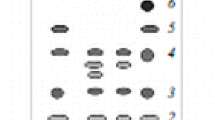Summary
A specific test for inositol is based on the fact that the residue obtained by evaporating the sample once with concentrated nitric acid contains acidic keto compounds which yield a red product when evaporated with calcium chloride and ammonia and then heated to 180°.
If an inositol solution containing silver nitrate is taken to dryness and then heated to 150°, metallic silver is deposited. This test for inositol cannot be employed if reducing sugars are also present.
These two tests can be conducted within the technique of spot test analysis. The respective identification limits are: 2.5μg and 0.05μg.
Zusammenfassung
Ein spezifischer Nachweis von Inosit kann darauf begründet werden, daß nach einmaligem Abdampfen mit konz. Salpetersäure ein Rückstand von sauren Ketoverbindungen hinterbleibt, der nach Abdampfen mit Calciumchlorid und Ammoniak und Erhitzen auf 180° ein rotes Produkt bildet.
Wird eine silbernitrathaltige Inositlösung zur Trockne verdampft und dann auf 150° erhitzt, so erfolgt Abscheidung von metallischem Silber. Diese Redoxreaktion kann bei Anwesenheit von reduzierenden Zuckern nicht zum Nachweis von Inosit verwendet werden.
Die beiden hier beschriebenen Nachweise sind in der Technik der Tüpfelanalyse ausführbar und besitzen Erfassungsgrenzen von 2,5μg bzw. 0,05μg Inosit.
Résumé
On a mis au point un test spécifique de l'inositol fondé sur les observations suivantes: en évaporant une fois l'échantillon en présence d'acide nitrique concentré on obtient un résidu contenant des composés cétoniques acides qui, par évaporation en présence de chlorure de calcium et d'ammoniaque suivie d'un chauffage à 180°, donnent naissance à un produit rouge. Si l'on évapore jusqu'à siccité une solution d'inositol contenant du nitrate d'argent et si l'on chauffe ensuite à 150°, il se forme un dépôt d'argent métallique. Ce test de l'inositol ne peut être utilisé en présence de sucres réducteurs. Ces deux tests peuvent être effectués dans le cadre de la technique des essais à la touche; les quantités limites qu'ils permettent d'identifier sont respectivement de 2,5μg et 0,05μg.
Similar content being viewed by others
References cited
O. Gelormini andN. E. Artz, J. Amer. Chem. Soc.52, 2483 (1930).
CompareP. Fleury andP. Balatre, Les Inositols. Paris: 1947. Chapter IV.
P. Denigès, L. Chelle andA. Labat, Precis de chimie analytique, 7th ed. Vol. I. Paris: 1930. p. 208.
P. Fleury andP. Balatre, 1. c. p. 32.
E. Salkowshi, Z. physiol. Chem.69, 478 (1910).
J. Scherrer, Ann. Chem.81, 375 (1852).
F. Feigl andCl. Costa Neto, Analyt. Chemistry (submitted for publication).
F. Feigl andL. Vokač, Mikrochim. Acta [Wien]1955, 101.
Author information
Authors and Affiliations
Rights and permissions
About this article
Cite this article
Feigl, F., Gentil, V. Spot test detection of inositol. Mikrochim Acta 43, 1004–1007 (1955). https://doi.org/10.1007/BF01223998
Received:
Issue Date:
DOI: https://doi.org/10.1007/BF01223998




